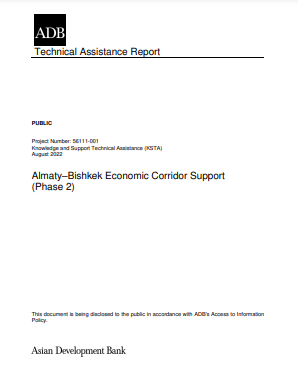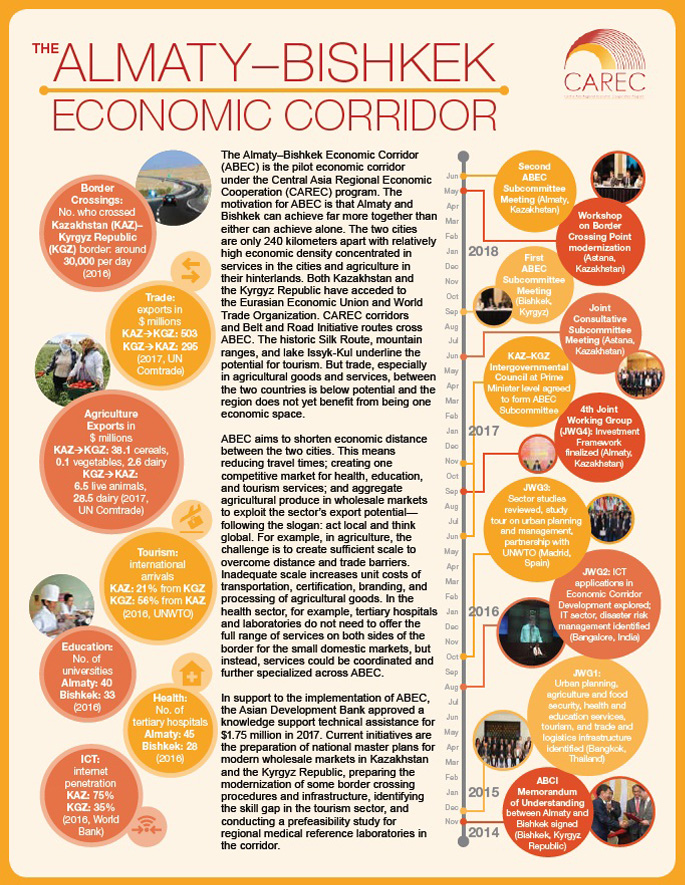The Almaty–Bishkek Economic Corridor (ABEC) is the pilot economic corridor under the Central Asia Regional Economic Cooperation (CAREC) program. ADB serves as the secretariat for the CAREC Program and ABEC Initiative. Implementing an economic corridor between Almaty, Bishkek, and the surrounding regions since 2014, ABEC seeks to connect people, businesses, and ideas to shorten economic distance between the two cities of Almaty and Bishkek. This means reducing travel times; creating one competitive market for health, education, and tourism services; and aggregate agricultural produce in wholesale markets.
The vision of the economic corridor is that the two cities and its surrounding regions can achieve far more together than either can achieve alone. ABEC is guided by the Intergovernmental Council, which is chaired by the two Prime Ministers of the Kyrgyz Republic and Kazakhstan. The Council created the ABEC Subcommittee, a regular official meeting of the two national governments, regional governments, and private sector representatives, which is co-chaired by the Kazakh vice-minister of National Economy and the Kyrgyz deputy minister of Economy and Finance.
What is an economic corridor?
Developing economic corridors is a priority for the CAREC Program, which has funded infrastructure connectivity among member countries for more than a decade. As CAREC member countries become more developed and connected to each other, they can benefit by cooperating at a higher level by linking markets, ideas, and people.
Economic corridor development (ECD) can be instrumental in promoting the regional cooperation agenda. ECD is concerned with the spatial organization of economic activities. It brings together existing and new infrastructure, policies, and institutions to attract private investment that will create jobs and encourage growth. Infrastructure requirements encompass transport networks (primary and secondary roads, railways, ports, airports), energy, information and communication technology, urban infrastructure, and economic zones.
ECD overlaps naturally with urban development: it supports the growth of large economic clusters, which are typically urban, and improves links between urban clusters, and between urban and rural areas.
An economic corridor is a spatial concept. It defines a geographic region dedicated to or dominated by economic activities that may typically be focused on specific sectors such as information technology, production of specific manufactured commodities, tourism, etc.
An economic corridor includes as prerequisites a good transport network; primary and secondary roads; and other infrastructure such as power, information and communication technology, and industrial parks.
What is needed to develop an economic corridor?
Experience across Asian countries shows that a few factors are critical to an economic corridor’s success:
- Economic potential. An economic corridor cannot develop from nothing; rather, it magnifies and builds on underlying economic potential, which can subsequently attract private investment. The starting point for economic corridor development is selecting and prioritizing a target geographical area based on identified economic potential.
- Economic and technical analysis to (a) identify ways of building on economic potential and prioritize where and how resources should be allocated; and (b) identify business opportunities, infrastructure needs, and policy and regulatory prerequisites
- Political commitment and coordination among multiple stakeholders at various levels of government, diverse government agencies at each level, and countries (for cross-border economic corridor development). Political commitment at the highest levels is another prerequisite for ensuring the successful development of economic corridors.
- Sustained commitment over a decade or more. Since economic corridor development typically requires public and private investment in infrastructure, completing projects will take substantial time and resources. Successful growth of firms in the corridor can also take time.
The Almaty–Bishkek Corridor Initiative
Kazakhstan and the Kyrgyz Republic are following a bold vision in the heart of Central Asia: to see the potential of the dense economic centers –Bishkek and Almaty– and the area around them as a single economic space. The two cities are only 240 kilometers apart but, at the moment, traveling from one city to the other takes around five hours, including a cumbersome border crossing in between. This makes exchange difficult and renders trade below potential.
The concept is straightforward. The two city regions can achieve far more together than what can be achieved by either alone. The Almaty–Bishkek Economic Corridor (ABEC), which emanated from the Almaty Bishkek Corridor Initiative (ABCI), transforms the area into a single space where exchange of ideas and movement of goods and people is fast, easy and free of barriers. The cross-border agglomeration will allow businesses to specialize more, operate at a larger scale and achieve greater diversification and competitiveness with the purpose of exporting goods and services to the world.
ABEC gives both countries the chance to design cooperation and coordinate the steps toward each other – a process that is guided by growing mutual trust in the benefits for both sides. To begin the implementation of the corridor, both countries have agreed to coordinate ABEC at the highest level through the Intergovernmental Council, which is chaired by the two Prime Ministers. With continuous support from the Asian Development Bank, sectoral working groups are being formed to implement pilot projects in agriculture and tourism sectors, while the institutional setup and projects in other sectors like health, education, and transport are in preparation.





